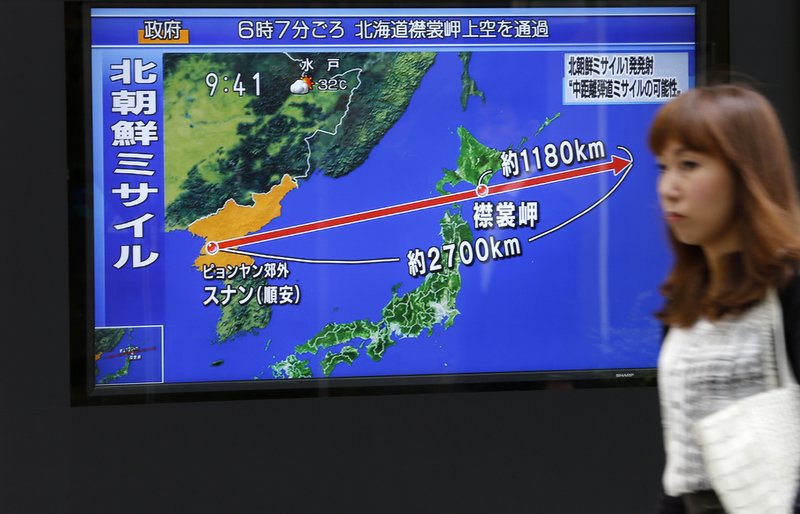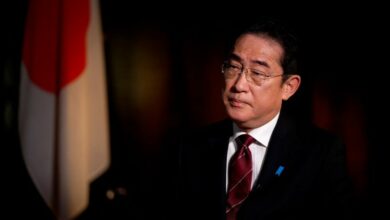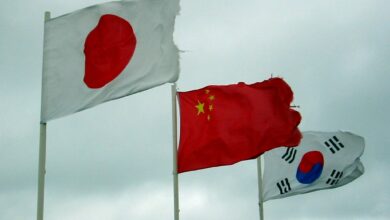
North Korea fired a ballistic missile over Japan’s northern Hokkaido island into the sea early on Tuesday, prompting warnings to residents to take cover and drawing a sharp reaction from Japanese Prime Minister Shinzo Abe.
The test, one of the most provocative ever from the reclusive state, came as US and South Korean forces conduct annual military exercises on the peninsula, angering North Korea which sees them as a preparation for invasion.
North Korea has conducted dozens of ballistic missile tests under young leader Kim Jong Un, the most recent on Saturday, in defiance of UN sanctions, but firing projectiles over mainland Japan is rare.
“North Korea’s reckless action is an unprecedented, serious and a grave threat to our nation,” Japanese Prime Minister Shinzo Abe told reporters.
Abe said he spoke to US President Donald Trump on Tuesday and they agreed to increase pressure on North Korea. Trump also said the United States was “100 percent with Japan”, Abe told reporters.
The US disarmament ambassador said Washington still needed to do “further analysis” of the launch, but it will be the subject of a UN Security Council meeting later in the day.
“It’s another provocation by North Korea, they just seem to continue to happen,” US envoy Robert Wood told reporters in Geneva.
“This is a big concern of course to my government and to a number of other governments,” Wood said before a session of the UN-sponsored Conference on Disarmament where North Korean Ambassador Han Tae Song was to speak.
South Korea’s military said the missile was launched from near the North Korean capital, Pyongyang, just before 6 a.m. (2100 GMT Monday) and flew 2,700 km (1,680 miles), reaching an altitude of about 550 km (340 miles).
Four South Korean fighter jets bombed a military firing range on Tuesday after President Moon Jae-in asked the military to demonstrate capabilities to counter North Korea.
South Korea and the United States had discussed deploying additional “strategic assets” on the Korean peninsula, the presidential Blue House said in a statement, without giving more details.
North Korea remained defiant.
“The US should know that it can neither browbeat the DPRK with any economic sanctions and military threats and blackmail nor make the DPRK flinch from the road chosen by itself,” North Korea’s official Rodong Sinmun said, using the initials of the North’s official name, the Democratic People’s Republic of Korea.
Global markets reacted to the escalation in tension, buying safe-haven assets such as gold, the Swiss franc and even the Japanese yen on expectation domestic investors would bring large amounts of currency home in times of uncertainty.
Stocks fell, with Japan’s Nikkei 225 index .N225 closing down half a percent, and South Korea’s KOSPI index .KS11 0.25 percent lower.
Some experts said the test appeared to have been of a recently developed intermediate-range Hwasong-12 missile, but there was no clear consensus.
This month, North Korea threatened to fire four missiles into the sea near the US Pacific territory of Guam after Trump said it would face “fire and fury” if it threatened the United States.
“Alas, Pyongyang has demonstrated that its threats to the US base on Guam are not a bluff,” Konstantin Kosachev, chairman of Russia’s upper house of parliament’s international affairs committee, said on social media.
North Korea fired what it said was a rocket carrying a communications satellite into orbit over Japan in 2009 after warning of its plan. The United States, Japan and South Korea considered it a ballistic missile test.
“I was woken by the missile alert on my cellphone,” said Ayaka Nishijima, 41, an office worker on Honshu island.
“I didn’t feel prepared at all. Even if we get these alerts there’s nowhere to run. It’s not like we have a basement or bomb shelter, all we can do is get away from the window,” she told Reuters by text message.
This month, the 15-member UN Security Council unanimously imposed new sanctions on North Korea in response to two long-range missile launches in July.
US Secretary of State Rex Tillerson appeared to make a peace overture to North Korea last week, welcoming what he called the restraint it had shown by not conducting any tests since July.
The United States has said all options, including military, are on the table, although its preference is for a diplomatic solution.
Some experts said Kim was trying to pressure Washington to the negotiating table with the latest tests.
“(North Korea) thinks that by exhibiting their capability, the path to dialogue will open,” Masao Okonogi, professor emeritus at Japan’s Keio University, said by phone from Seoul.
“That logic, however, is not understood by the rest of the world, so it’s not easy,” he said.
The Japanese military did not attempt to shoot down the missile, said Minister of Defence Itsunori Onodera. The missile may have broken into three pieces, but that was not clear, he added.
Experts say defenses in Japan and South Korea that are designed to hit incoming missiles would struggle to bring down a missile flying high overhead.
Australian Prime Minister Malcolm Turnbull said China, North Korea’s main ally and trading partner, needed to do more.
“China has to ratchet up the pressure,” Turnbull told Australian radio. “They have condemned these missiles tests like everyone else but with unique leverage comes unique responsibility.”
China said it opposed North Korea defying UN resolutions but adding that sanctions and pressure could not fundamentally solve the issue.
The only correct way to resolve the issue is via talks to address each other’s reasonable security concerns, Foreign Ministry spokeswoman Hua Chunying told reporters.
“The UN Security Council has put through several resolutions and sanctions have all along been put in place but everyone can see whether they’ve had actual results,” she added.
“On the one hand, sanctions have continued to be put in place via resolutions and on the other hand North Korea’s nuclear and missile launch process is still continuing.”
The United States and South Korea are technically still at war with the North because their 1950-53 conflict ended in a truce, not a peace treaty. The North says it will never give up its weapons programs, saying they are necessary to counter hostility from the United States and its allies.




